How to properly connect an RCD without grounding - the circuit and its pros and cons
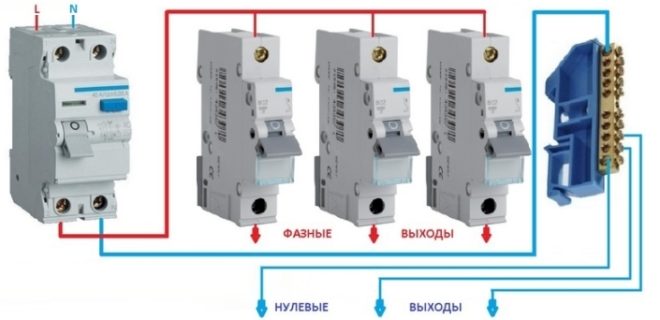
The fact that it is necessary to install residual current devices in modern houses and apartments has already been said many times. Their main goal is to protect human life from the action of electric current. But is it always possible to carry out the installation, given that the network is different - three-phase and single-phase, with and without a grounding protective conductor. Let's talk about how to connect an RCD without grounding. The scheme by which these devices are connected is not complicated. If you yourself do all the apartment wiring, you will be able to cope with the installation of an RCD. But the most correct decision would still be to entrust this work to professionals.
Before talking about how to connect an RCD without grounding, you must have a clear understanding of the types of electrical household networks.
Content
Varieties of electrical networks
Our apartments and houses are supplied with electricity from a single-phase or three-phase network.
Single phase power supply is one phase and zero. To power household appliances and lighting devices, you need a phase voltage, which is obtained at the output after a step-down transformer. This single-phase power supply assumes power supply from one phase of the line.
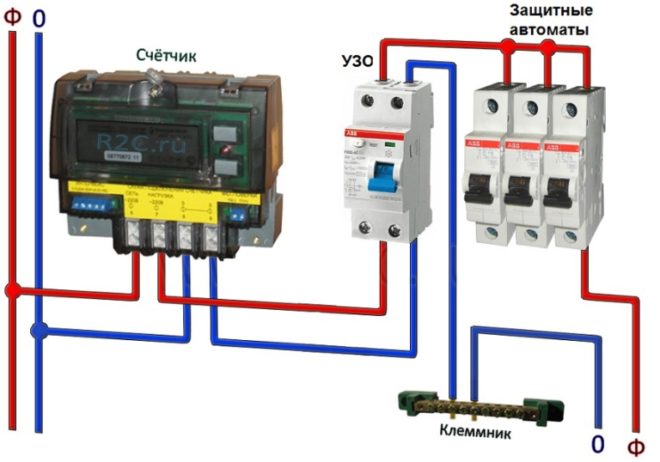
An electric current moves along the phase conductor, and along the zero conductor it returns to the ground. Most often, this type of wiring is applicable in an apartment, and it has two varieties:
- Single-phase network of two-wire design (without ground). This type of electrical network can most often be found in houses of old buildings; it does not provide for grounding of electrical appliances. The circuit includes only the neutral wire, marked with the letter N, and one phase conductor, it is respectively designated by the letter L.
- Single-phase three-wire network. In addition to zero and phase, it also has a protective grounding conductor, designated PE. The cases of electrical devices must be connected to grounding conductors, this will protect the equipment itself from burnout, and the person from the action of electric current.
There is often equipment in the house that needs three-phase voltage (pumps, motors, if there are machines in a barn or garage). In this case, the network will consist of zero and three phase wires (L1, L2, L3).
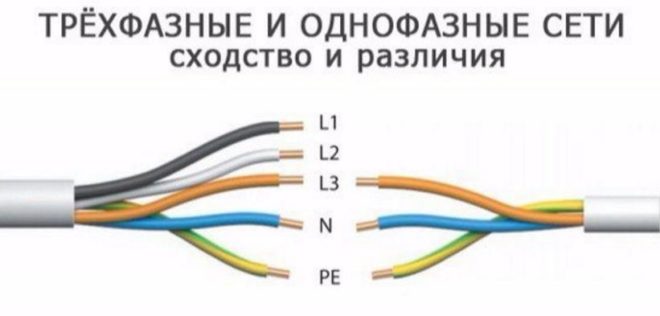
Similarly, a three-phase network can be of a four-wire version and a five-wire one (when a protective ground conductor is still present).
We have decided on the types of networks, and now we will go directly to the question, is it possible to connect an RCD without grounding and how to properly install this device?
Is it possible to connect an RCD without grounding - in the video:
What is the need to install an RCD?
Let's consider this question with a simple example. Suppose there is a washing machine in the bathroom. Apartment electrical wiring is made only with neutral and phase wires, there is no protective grounding, and the RCD is not mounted.
We present the situation further. The insulating layer inside the machine was damaged, as a result of which the phase began to come into contact with the metal housing. Some potential has appeared, that is, the body of the washing machine is now energized. If a person comes up to it and touches it, it will play the role of a conductor through which an electric current will flow. The action of the current will continue until the person pulls his hand away from the washing machine, because the damaged area will not be turned off by any device.Unfortunately, under the influence of the current, the human muscles are paralyzed, and it is not always possible to pull back the hand yourself.

There are two options here - either the person loses consciousness and gives in, or someone outside helps him by turning off the introductory machine to the room.
If, in the example considered, there was an RCD in the switchboard, it would react to the appearance of a leakage current, turn off and secure human life. It is for this reason that the installation of an RCD is simply necessary in an apartment equipped with a large number of powerful household appliances.
How does an RCD with and without grounding work?
What is the principle of an RCD in a two-wire network if there is no grounding? When an insulating breakdown appears on the device case, the residual current device will not work, because the case is not grounded and there is no path for the leakage current to pass. In this case, the body of the device will be under a potential hazardous to human life.
At the moment a person touches the body of the device, the current leakage will go to the ground through his body. When the magnitude of this current equals the RCD trip threshold, a trip will occur, and the voltage will not be supplied from the mains to the damaged electrical appliance.
How long a person will be under the influence of a leakage current depends on the RCD trip setting.

Although it will turn off quickly, this time may be enough to get serious electrical injury.
But if the case were connected to protective ground, the RCD would react and turn off immediately as soon as an insulating breakdown occurred.
As you can see, the RCD connection diagram without grounding is really applicable, but it does not give a 100% guarantee of safety. But since in old houses a two-wire electrical network is mainly made, and it is not so easy to convert it to a three-wire one, the only way to protect equipment and a person is to install an RCD.
A clear principle of operation of an RCD without grounding in the video:
The principle of operation of this device is based on measuring processes. The value of the current at the input and at the output is recorded. If these readings are the same, then there is no reason for triggering. As soon as a leakage current appears in the network, the output value will become smaller, and the device will disconnect the damaged section. The RCD works due to a tripping mechanism in conjunction with an electromagnetic relay.
Scheme options
Before connecting an RCD without grounding, remember this important advice! The circuit must necessarily include, in addition to residual current devices, ordinary machines.
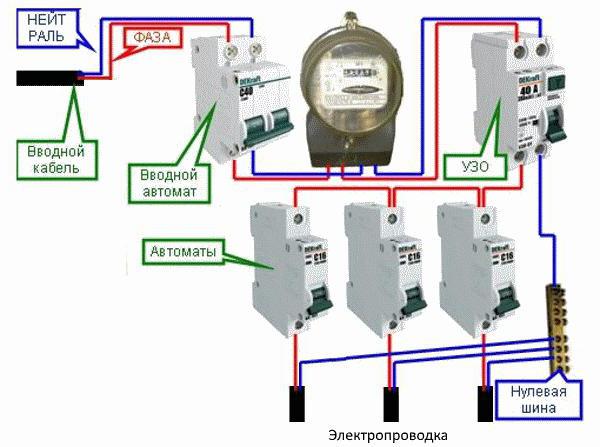
Many people naively believe that these are the same mechanisms and serve the same purpose. The main thing is to understand the difference in their work. The circuit breaker is a protection for the supply voltage. It shuts off the damaged section if overcurrents occur in it as a result of a short circuit or overload. Due to this, the emergency situation does not extend to the general network, and it remains in good condition.
RCD protects only from current leaks, their values are very small in comparison with short-circuit currents. Therefore, if a short circuit or overload mode occurs in the network and there is no automatic device, the RCD will not respond. It should always be installed in a circuit paired with a circuit breaker.
Connecting an RCD without grounding can be done in two ways.
Input connection
With this scheme, one RCD is installed to ensure the protection of all apartment wiring at the same time.
Voltage is supplied from the network via the lead-in cable to the switchboard and comes to the two-pole circuit breaker. Then a residual current device is installed in the circuit. Further, the machines of the outgoing connections are mounted. All these outgoing consumers are simultaneously protected by one RCD installed at the input.
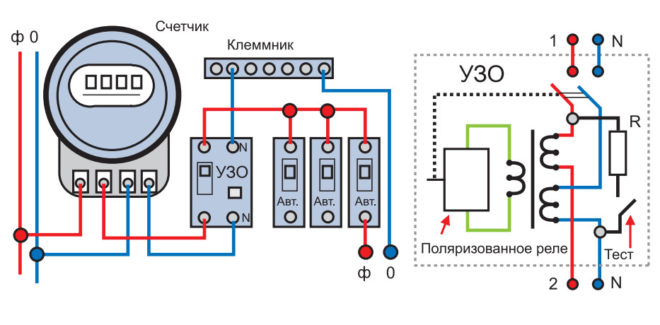
The advantage of this scheme is that only one residual current device is used, therefore, significant material costs are not required. In addition, everything can be compactly placed in the switchboard and it will not be large.
But there is also a significant drawback. Imagine that some household appliance is currently connected to an outlet and a phase is shorted to a metal case in it. The RCD reacts to the emerging current leakage and turns off. The voltage supply to the entire apartment is cut off. If at that moment only one electrical appliance was connected to the outlet, it is not difficult to look for damage. And if a lot of household appliances were working at the same time? Not only that, immediately after the power was cut off, the refrigerator stopped working, the air conditioner stopped working, the program in the washing machine or bread maker stopped, and unsaved documents remained on the computer. So it will still be necessary to find which particular technique the phase closed on, and this already causes certain difficulties.
Therefore, before choosing this RCD connection scheme, think about the convenience of its further operation.
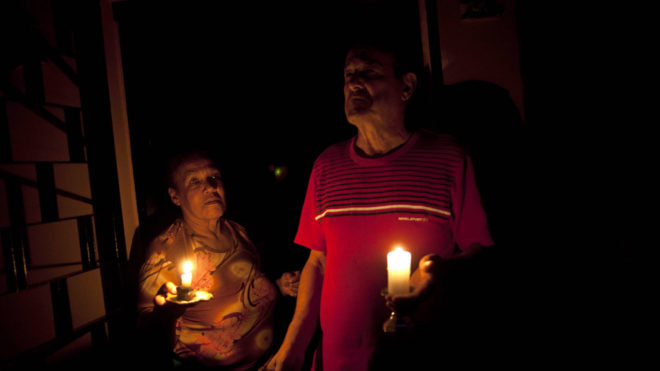
Connection at the entrance and outgoing branches
This version of the circuit provides for the connection of several RCDs. One, as discussed above, is mounted after the input machine at the entrance. The rest are installed behind the circuit breakers of the outgoing connections. How many there will be depends on how you group your home electrical network. Perhaps you will have one machine and one RCD for each separate room. There is a variant of separation of socket and lighting groups of consumers. Some schemes provide separate protection for the boiler, washing machine, dishwasher, air conditioner or electric oven.
How does this scheme work? For example, a current leak has occurred on one of the outgoing lines. An RCD protecting this particular line will work. The tension in the entire apartment does not disappear, all other equipment remains in working order. This is the undoubted advantage of this version of the scheme. Its disadvantage is that the switchboard will turn out to be impressive in size, it is not very convenient to place a large number of RCDs and automatic machines in it. Yes, and it will not be cheap in material terms.
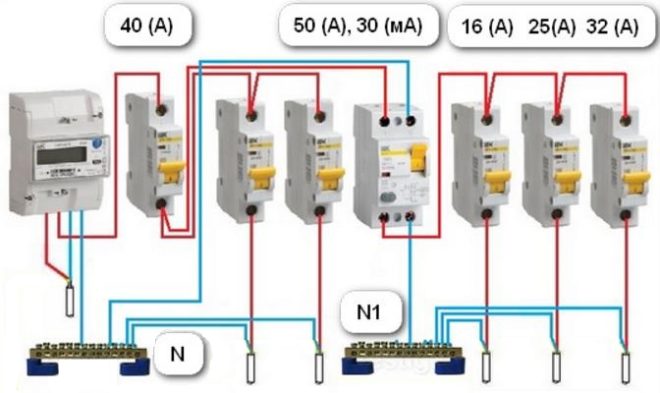
The question arises, why is there another RCD at the input in the circuit? There are situations when, for one reason or another, the outgoing device did not react to the current leak. In this case, the input RCD will be a safety net, after a certain period of time it will turn off. In principle, it can be omitted and the circuit can be executed without an input device. But if the financial possibilities allow, it is better to insure yourself, after all, we are talking about the safety of people.
The general principle of connecting an RCD is clearly visible in the following video:
Assembling the circuit
There are no difficulties in practical implementation. The whole work algorithm will look like this:
- All work with electricity always begins with the de-energization of the workplace. Therefore, turn off the apartment input machine. Using an indicator screwdriver, make sure that there is really no voltage at its output.
- Attach the residual current device to the DIN rail. On the back side there are latches on it, which must be inserted into the perforated holes on the rail.
- The housing of the residual current device is marked with input and output contacts for neutral and phase conductors. The power supply to the RCD is supplied from above, and the load is connected from below. From the output terminal of the circuit breaker, connect the phase conductor "L" to the corresponding input terminal of the RCD. Do the same connection with the neutral wire "N".

- Distribute the phase output from the RCD to all circuit breakers of the outgoing lines.
- Connect the output from the zero contact to the zero bus. And already from it, the conductors will disperse to consumers.After the RCD, the neutral conductors are not combined into one node, this will cause false alarms of the device.
- After completing all the commutations, turn on the introductory machine. Check the correct connection and operation of the residual current device. For this, there is a special TEST button on the RCD case. Its main purpose is to simulate current leakage. From the phase conductor, the current is supplied to the resistance, and from it, bypassing the transformer, to the neutral conductor. Due to the resistance, the current became less at the output and due to the resulting imbalance, the tripping mechanism will work. Press the test button, the RCD should shut down. If this does not happen, then there are inaccuracies in the connection or the device is not working properly.
Common mistakes when connecting an RCD on video:
If you will connect an RCD with grounding, remember that it is unacceptable to use water pipes or other communication facilities for this purpose.

Grounding must be done correctly, and not done by yourself, only in this case you can be completely confident in safety. If the grounding is inoperative, then be sure to disconnect and insulate the conductors coming to the shield from electrical appliances.




